The Peacock Angel was the Seventh Ancestor
Updated Sept 9, 2023
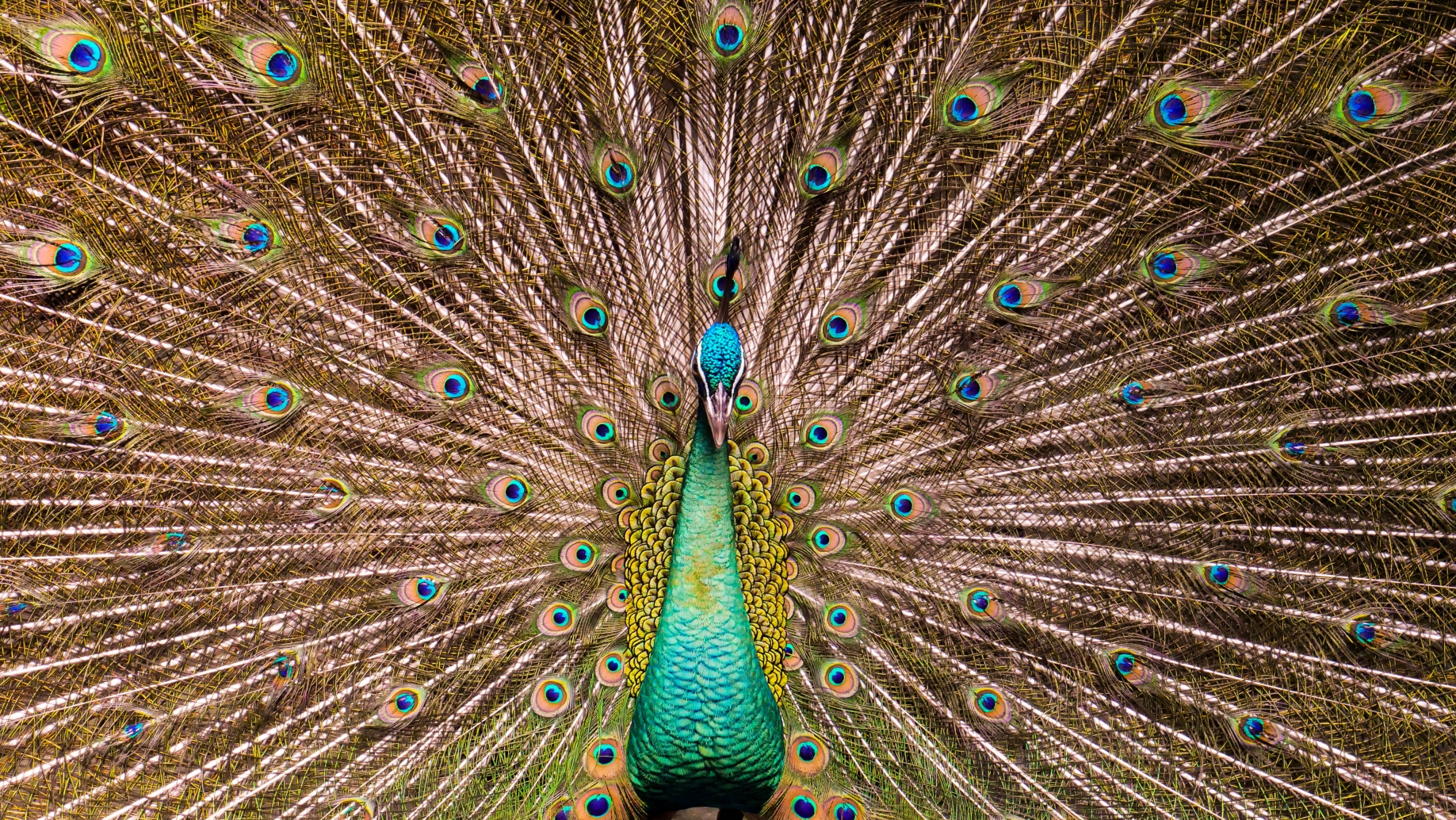 Peacock by Mallory CessairBy Mallory Cessair - Own work, CC BY-SA 4.0, https://commons.wikimedia.org /w/index.php?curid=132676561 Gembira Loka Zoo, Yogyakarta |
My research associates the peacock with the Seventh Nummo Ancestor, who was part human and part alien Nummo. In the Dogon religion, she was a benevolent, androgynous figure, who was sacrificed for the betterment of humanity.Dorey, The Master (Mistress) of Speech p. 81 The peacock is an important ancient symbol that I believe originated with this figure, who was also known as the Master (Mistress) of Speech. Before Christianity, the peacock became a symbol of the Roman Goddess Juno, who was also the Greek Hera. Once Christianity came into vogue, the peacock was a symbol for Jesus Christ.Dorey, The Nummo p. 64 I believe that the Peacock Angel Tawûsê Melek, who was worshipped by the Yazidis, is also associated with the Seventh Nummo Ancestor (Master (Mistress) of Speech).Dorey, Day of the Fish p. 79
The Yazidis trace their roots back to ancient Mesopotamia, located in present-day Iraq, Turkey, and Syria with significant numbers in Armenia and Georgia.https://en.wikipedia.org/wiki/Yazidis The Peacock Angel Tawûsê Melek is the most distinguished of a Heptad of seven Holy Beings, known as the Angels of the Seven Mysteries heft sirr.https://en.wikipedia.org/wiki/Melek_Taus It is interesting to note that peacocks are not native to the ancient Mesopotamian lands where the Peacock Angel, Tawûsê Melek is worshipped.https://en.wikipedia.org/wiki/Melek_Taus
In the Dogon religion, the Seventh Nummo Ancestor was considered the purest of the Eight Nummo Ancestors. She was known as the Master (Mistress) of Speech, because she had the perfect combination of Nummo and human DNA, known as the perfect "Word".Dorey, The Master (Mistress) of Speech p. 81
In the Middle Ages, the peacock was a symbol of immortality because it was believed that its flesh never decayed. The Dogon described the alien Nummo and Nummo Ancestors as being immortal beings.Dorey, The Master (Mistress) of Speech p. 13
In the Dogon religion, the blue and white donu bird was a symbol of Seventh Nummo Ancestor (Master (Mistress) of Speech), which is how I beleive the peacock may have eventually become associated with this figure. The Donu bird was believed to have been born from the Seventh Nummo Ancestor's sacrifice.Dorey, The Rose p. 263 The French anthropologists Marcel Griaule and Germaine Dieterlen weren't sure which bird was the Donu bird but they believed it might be a water bird that emigrated to Sanga in the torrents of rain during the rainy season.Dorey, The Rose p. 281 The water bird association is important because the alien Nummo and the Eight Nummo Ancestors were primarily aquatic beings.Dorey, The Nummo p. 188 They also had gizzards like birds.Dorey, Day of the Fish p. 173
In addition to the blue and white Donu bird, the Dogon used an ostrich to depict the Seventh Ancestor (Master (Mistress) of Speech). This was because the ostrich's body,"shown by concentric circles, was marked with chevrons," which were symbols associated with water and the Seventh Nummo Ancestor.Dorey, The Rose p. 263 I believe that the ostrich's markings may be another reason why the peacock eventually became associated with this figure.Dorey, The Rose p. 118
Because the Seventh Ancestor (Master (Mistress) of Speech) was a hermaphrodite, and part alien Nummo and human, she was considered a twin or dual. I believe this is why you often see dual peacocks in association with this sacrificial figure.
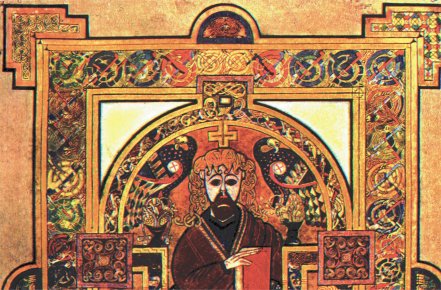 32 Verso Book of KellsDorey, The Nummo p. 203 |
On this picture of Christ from the Celtic Book of Kells, he is depicted with dual peacocks.Dorey, The Nummo p. 203 The saw teeth or chevrons found on ostriches and described by Griaule appear on the tails of the twin peacocks shown above.Dorey, The Rose p. 263
Besides being associated with the blue and white Donu bird, the Seventh Nummo Ancestor (Master (Mistress) of Speech) was described as having a human upper body and a fish-tailed lower body. The fish has long been a popular Christian symbol, which suggests the Seventh Nummo Ancestor, a figure who according to my research predates Christianity, probably influenced the later Christian myth.Dorey, The Master (Mistress) of Speech p. 203
It is believed that the Book of Kells was created in the ninth century in the monastery of Saint Colm Cille, which is on the Island of Iona off the west coast of Scotland. The original manuscript was thought to have come from the Celtic pagan religion and was later transcribed to accommodate the four Christian gospels.Dorey, The Rose p. 264
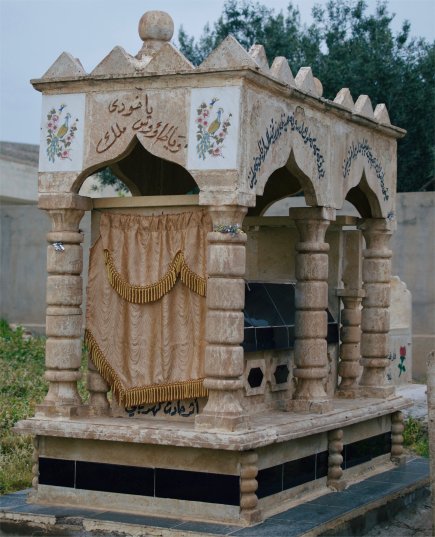 Yazidis Shrine by Levi ClancyYazidis village, Baadre, Dohuk Governorate, Kurdistan Region, in Iraq by Levi Clancy - Own work, CC BY-SA 4.0, https://commons.wikimedia.org/w/ index.php?curid=63446172 cropped and reduced |
The Peacock Angel Tawûsê Melek, who is worshipped by the Yazidis, is also depicted dual on the above shrine from a Yazidis village in the Kudistan Region of Iraq.Yazidis village, Baadre, Dohuk Governorate, Kurdistan Region, in Iraq by Levi Clancy - Own work, CC BY-SA 4.0, https://commons.wikimedia.org/w/index.php?curid=63446172
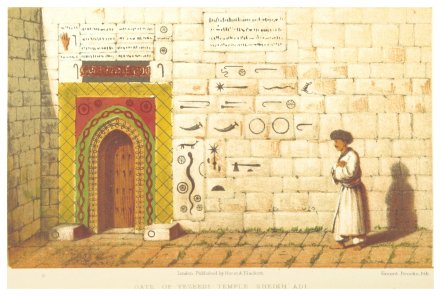 Gate of Yazidis Temple 1865Image extracted from page 454 of A journey from London to Persepolis; including wanderings in Daghestan, Georgia, Armenia., by USSHER, John. 1865 Original held and digitised by the British Library. Copied from Flickr.British Library HMNTS 10076.g.6 https://en.wikipedia.org/wiki/Yazidis#/ media/File:USSHER(1865)_p454_GATE_OF _YEZEEDI_TEMPLE_SHEIKH_ADI.jpg |
On the door of this Yazidis temple, dated 1865, we see the serpent to the right, which is another representation of the Seventh Nummo Ancestor (Master (Mistress) of Speech), who also appeared on Dogon shrines as a serpent.Dorey, Day of the Fish p. 78 Other Dogon symbols that appear here are the hammer and anvil, the mound, the Smith's hook, wheel, the dog or Jackal, the sun, and a hand, which are referred to in my books.Dorey, Day of the Fish pp. 195-205 and The Master (Mistress) of Speech pp. 154-155
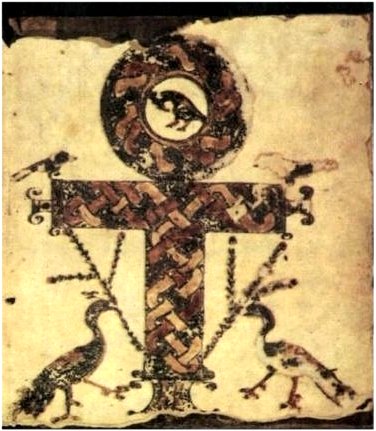 Codex GlazierDorey, The Nummo p. 46 |
Twin peacocks are depicted again on this ankh cross from the Codex Glazier, which is a 4th-5th century manuscript of the New Testament in Coptic, which contains text of the Book of Acts 1:1-15:3.Dorey, The Nummo p. 46
The weaving pattern on the ankh cross is significant. It is associated with the Seventh Ancestor (Master (Mistress) of Speech), who was said to have taught weaving to humans, and whose DNA was woven into the fabric of humanity. This is why seven in the Dogon language soy, also meant woven material. Soy also meant "the Word", a symbol for DNA.Dorey, The Nummo p. 47
Essentially the woven cloth was "the Word" or the DNA. In this way, weaving was considered a form of procreation and "the "clapping of the shuttle and creaking of the block" was called the "creaking of the Word."Dorey, The Nummo p. 47
Another important aspect of this image is that it shows an anvil beneath a cross. The anvil was a symbol of the Female Great Nummo and is often absent from depictions of crosses in later patriarchal religions. In the Dogon religion, the hammer, which looked like a cross, symbolized the Male Nummo and the hammer and anvil together represented the hermaphroditic Nummo.Dorey, The Nummo p. 44
It was believed that the seeds or DNA came down from the Nummo's world in the Smith's hammer and anvil. The number 256 was identified with the Smith's hammer and represented the "womb of all the world signs."Dorey, The Nummo p. 91
The Smith's hammer and anvil were considered the first musical instruments. When the Dogon Smith struck the rock (anvil) with the hammer, this symbolized the Nummo bringing a divine note into human disorder. The anvil and bellows evolved into a collection of musical instruments, with the drum replacing the bellows, iron hand bells, the anvil, and drumsticks, the hammer.Dorey, The Nummo p. 86
Music was associated with the first rhythm of resurrection. Lébé, the mother/father of humanity, and also known as the Eighth Ancestor, was born as a result of the sacrifice of the Seventh Ancestor. The musical octave was a metaphor for this birth.Dorey, The Master (Mistress) of Speech p. 262
 Tanbour by I, AllauddinBy I, Allauddin, CC BY-SA 3.0, https://commons.wikimedia.org/w/index.php?curid=2315897 |
The tanbour, shown above, is associated with the Yarsan religion which has similar beliefs to Yazidism. It is one of the few musical instruments used in Ahl-e Haqq rituals, and practitioners venerate the tanbour as a sacred object.https://en.wikipedia.org/wiki/Kurdish_tanbur
The tanbour is similar to the lute, which I refer to in The Nummo. The long necked lutes were the more ancient lutes,https://en.wikipedia.org/wiki/Lute#History_and_evolution_of_the_lute and the Seventh Ancestor (Master (Mistress) of Speech) was depicted with a long neck by Dogon carvers. It may also represent the tail of the fish as the round part of the instrument may symbolize the body of a fish, another symbol associated with the Seventh Ancestor.Dorey, The Nummo p. 13
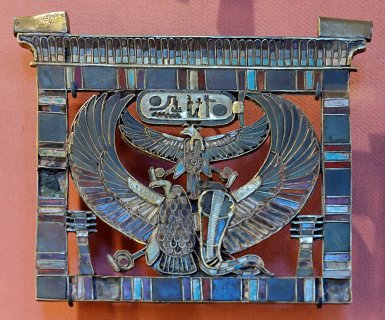 by Marie-Lan NguyenOriginal artist Unknown - Photo by Marie-Lan Nguyen (2006), Public Domain, https://commons.wikimedia.org/w/ index.php?curid=1301306 Louvre Museum |
This Egyptian amulet found in the Louvre depicts Horus, Wadjet and Nekhbet and is dated 1279-1213 BCE. My research associates all three of these figures with the Mistress (Master) of Speech.Dorey, The Nummo pp. 52-53 and p. 314 The markings and the blue colours of these figures are similar to peacocks. Wadjet was sometimes depicted as a woman with two snake heads and at other times, a snake with a woman's head… The Going Forth of Wadjet was celebrated on December 25 with chants and songs.Dorey, The Nummo p. 314
While Wadjet was the tutelary deity of lower Egypt, her counterpart Nekhbet (vulture) was the tutelary deity of Upper Egypt. The two often appeared together as the "Two Ladies". One of the titles of each ruler was the Nebty name, which began with the hieroglyphs for [s/he] of the Two Ladies.... Dorey, The Nummo p. 63 In the Dogon religion, the name Lébé was a combination of the two Dogon words, "ley be", an expression which meant "those two" or "two together". Lébé was a regeneration of the Seventh and Eighth Ancestors DNA and both Ancestors were hermaphrodites but primarily female. Lébé, who was considered the mother of all humans, was born as an hermaphrodite but five generations after her birth humans were born single sexed. Her birth was considered the hope for humanity as humans would eventually regain their immortality.Dorey, The Nummo p. 63
In the Book of the Dead, Nekhbet (vulture) is referred to as "Father of Fathers, Mother of Mothers, who hath existed from the Beginning, and is Creatrix of this World." I believe she is a Master (Mistress) of Speech figure, who is depicted as a vulture in this instance instead of a peacock or ostrich.Dorey, The Nummo p. 63
Both the alien Nummo and the Seventh Ancestor (Mistress/Master of Speech) were symbolized by red giant suns in the Dogon religion.Dorey, The Rose pp. 8-24 In astrophysics, large red giant suns explode as supernovas to regenerate the universe creating new planets and suns. The Yaresan believe "the Sun and fire are holy things and follow the principles of equalization, purity, righteousness, and oneness."https://en.wikipedia.org/wiki/Yarsanism
Through their history, the Yazidi people have endured and survived 72 genocides and centuries of persecution as "devil worshippers" as they upheld their religious beliefs about the Peacock Angel. They have faced severe Islamic persecution and attempts to force them to convert to Islam by the Ottoman Empire and later in the 20th century by Iraq.https://en.wikipedia.org/wiki/Yazidis
The Dogon people faced similar persecution in their refusal to convert to Islam and fled their original homeland sometime between the 10th and 13th centuries. After the Catholic French took over their territory and forced between Christianity and Islam, the Dogon people chose Islam, which is what most Dogon practice today.Dorey, Day of the Fish p. 47
For more information on the Dogon religion refer to my books, The Master (Mistress) of Speech, The Nummo, Day of the Fish and The Rose.